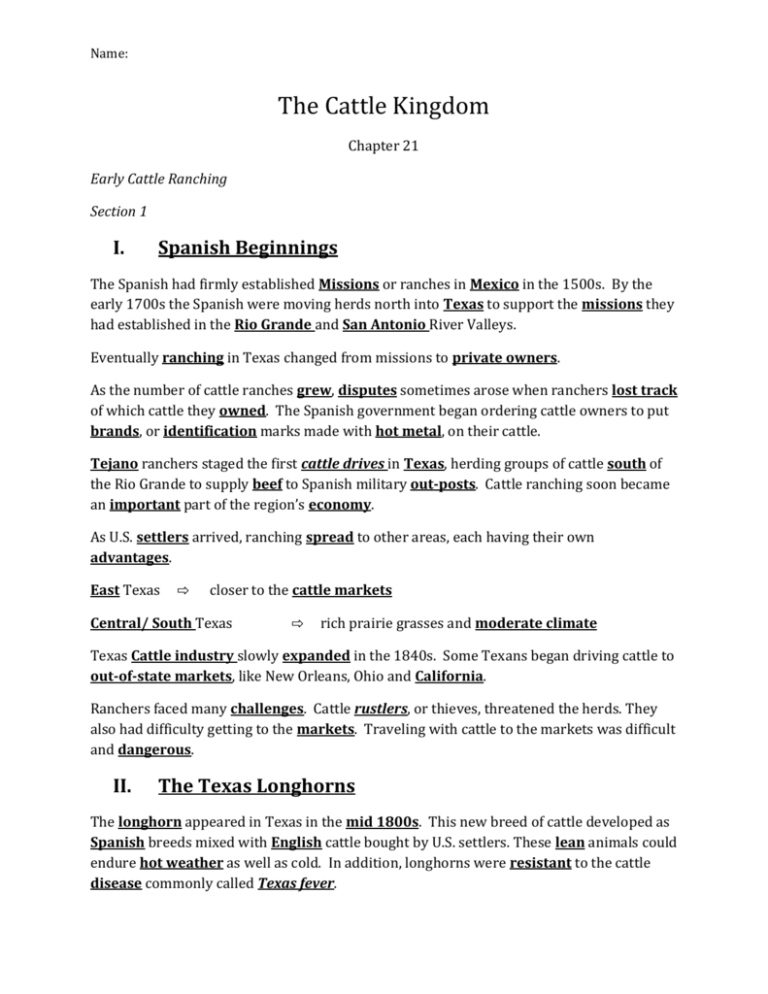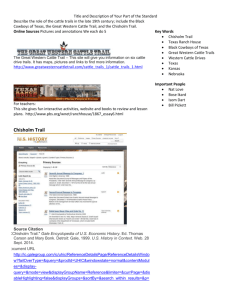The Cattle Kingdom
advertisement

Name: The Cattle Kingdom Chapter 21 Early Cattle Ranching Section 1 I. Spanish Beginnings The Spanish had firmly established Missions or ranches in Mexico in the 1500s. By the early 1700s the Spanish were moving herds north into Texas to support the missions they had established in the Rio Grande and San Antonio River Valleys. Eventually ranching in Texas changed from missions to private owners. As the number of cattle ranches grew, disputes sometimes arose when ranchers lost track of which cattle they owned. The Spanish government began ordering cattle owners to put brands, or identification marks made with hot metal, on their cattle. Tejano ranchers staged the first cattle drives in Texas, herding groups of cattle south of the Rio Grande to supply beef to Spanish military out-posts. Cattle ranching soon became an important part of the region’s economy. As U.S. settlers arrived, ranching spread to other areas, each having their own advantages. East Texas ⇨ closer to the cattle markets Central/ South Texas ⇨ rich prairie grasses and moderate climate Texas Cattle industry slowly expanded in the 1840s. Some Texans began driving cattle to out-of-state markets, like New Orleans, Ohio and California. Ranchers faced many challenges. Cattle rustlers, or thieves, threatened the herds. They also had difficulty getting to the markets. Traveling with cattle to the markets was difficult and dangerous. II. The Texas Longhorns The longhorn appeared in Texas in the mid 1800s. This new breed of cattle developed as Spanish breeds mixed with English cattle bought by U.S. settlers. These lean animals could endure hot weather as well as cold. In addition, longhorns were resistant to the cattle disease commonly called Texas fever. Name: Longhorns became more valuable as cattle ranching grew in Texas. When the Civil War broke out, the demand for Texas beef increased rapidly. The Confederate army needed to feed the troops. However, as the war dragged on, Texans found it difficult to move their cattle to the war front. By 1863 the Union army had blocked trade from Confederate states, including Texas. By the end of the Civil War, about 5 million cattle roamed the state. This is what led to the increase in the cattle trade. Texas Cattle Trails Section 2 I. The Cattle Drives Demand for beef outpaced supply in the Northeast. Texas cattle was more valuable in the Northeast. Cattle that sold for $3 or $6 a head in Texas, sold for $38 in Kansas or $80 in New York. Such high profits convinced Texas ranchers that they could make large profits by raising more cattle. By 1865, stockyards, or huge holding pens, and packing houses were opening in Chicago. Soon, more beef-processing plants were built farther west, in St. Louis and Kansas City. These plants were built to prepare the beef for shipment to cities in the North and East. Railroads connected cities in Midwestern states such as Missouri with the larger cities in the Northeast. To reach these additional markets, Texas ranchers needed a way to get their cattle to their nearest railroad lines. Cattle drives provided the answer. During the fall and winter, cattle grazed on the open range, or unfenced lands, of Texas. As spring approached, cowboys gathered cattle together in a roundup. Cowboys caught as many mavericks as possible and branded them to establish ownership of the animals. When the grass turned green in the spring, cowboys drove the cattle north. During one large cattle drive in 1866, cowboys moved about 260,000 cattle north over the Sedalia Trail, which became known as the Shawnee Trail. This trail led from South Texas through Indian Territory to Sedalia, Missouri. Toward the end of the trail, problems arose. As huge herds moved through the land, farmers’ crops were sometimes trampled. Name: The longhorn also infected many other cattle by giving them ticks that carried Texas Fever. This upset farmers, and Kansas and Missouri passed laws in an attempt to stop the cattle drives, and farmers began to turn back the Texas herds. With the future of Texas cattle drives seemed uncertain, Entrepreneur Joseph McCoy stepped in with a solution. McCoy knew that rail lines were moving farther west– by early 1867 tracks were being built by Kansas. McCoy arranged for the building of a cattle market complete with holding pens and loading chutes in Abilene Kansas. McCoy rebuilt Abilene and prepared it to be a cattle range center. To drum up business, McCoy sent scouts southward to urge Texas ranchers to bring their cattle to Abilene. II. The Chisholm Trail In 1867, Texas cowboys herded about 35,000 longhorns over the Chisholm Trail. The route to Abilene was named after Jesse Chisholm, a fur trader. The child of a Cherokee woman, Chisholm blazed the original trail in the mid-1860s to trade with American Indians. The Chisholm Trail was an ideal route for the Texas cattle drives because it was not near farms. Over the next few years, even more cowboys used this trail to move their herds to Abilene. In 1871 some 600,00 to 700,00 longhorns arrived in the cowtown. At the end of the drive, most ranchers sold the animals for a good profit and paid the cowboys in cash. Weary cowboys spent their hard earned money on hot baths, clean clothes, and good food. The large number of rowdy cowboys sometimes made cattle towns violent. Lawenforcement officials worked hard to keep the peace in the rough cattle towns. Name: III. The Western Trail Texas ranchers soon needed a new trail across the open range to the west of settled territory. The Western Trail was forged in 1874. The route ran north from Kerrville to Fort Griffin– well to the west of new towns. The trail crossed the Red River and continued through Indian Territory, ending at Dodge City in southwestern Kansas. By 1879 the Western Trail was the primary route for Texas cattle being moved north. IV. The Goodnight-Loving Trail Ranchers also saw opportunities to sell cattle to military posts, mining camps, and American Indian reservations. Charles Goodnight and Oliver Loving were two cattlemen who combined their herds and set out for Fort Sumner, New Mexico. Their route became known as the Goodnight-Loving Trail. The Goodnight-Loving Trail ran from west of Fort-Worth, through San Angelo, across West Texas, north through New Mexico and into Colorado. Over time, this trail became one of the most-traveled routes in the Southwest. V. Life on the Trail Cowboys represented many ranchers and supervised many herds on the cattle drives. Some ranchers drove their own cattle, but most hired a drover, or a cattle drive operator. Cattle-herding outfits also included a trail boss, or a drive leader. A typical cattle drive had 8-12 cowboys to care for 2,000 to 3,000 cattle. Each cowboy used several horses in relays of two or three, so that a fresh mount was always available. The herd of these horses was known as the remuda, the Spanish word for “remount.” A wrangler cared for the crew’s horses. The camp cook was another important member of the drive crew. Good food meant happy cowboys. The cook traveled ahead of the herd and had meals prepared when the rest of the outfit arrived. The cook’s supplies were carried in the chuck wagon. Name: After a hot breakfast of bacon, beans, and biscuits, the cowboys would choose their horse from the remuda and start to move cattle. On a good day, the herd would move 15-18 miles. About 5:00pm the crew stopped for the night. The dinner menu was usually beef or pork, but sometimes included “son-of-gun” stew. This thick soup was made from cow brain, heart, kidneys, liver and tongue. Trail drives were difficult and dangerous. The sunshine was hot and water was in short supply. Prairie fires swept across the plains, sometimes moving fast enough to overtake a cowboy on a galloping horse. Cowboys also had to deal with rustlers, or cattle thieves.








